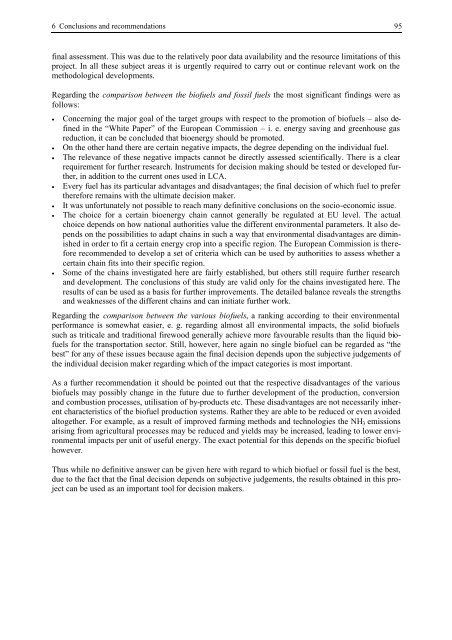BIOENERGY FOR EUROPE: WHICH ONES FIT BEST?
BIOENERGY FOR EUROPE: WHICH ONES FIT BEST?
BIOENERGY FOR EUROPE: WHICH ONES FIT BEST?
Create successful ePaper yourself
Turn your PDF publications into a flip-book with our unique Google optimized e-Paper software.
6 Conclusions and recommendations 95<br />
final assessment. This was due to the relatively poor data availability and the resource limitations of this<br />
project. In all these subject areas it is urgently required to carry out or continue relevant work on the<br />
methodological developments.<br />
Regarding the comparison between the biofuels and fossil fuels the most significant findings were as<br />
follows:<br />
• Concerning the major goal of the target groups with respect to the promotion of biofuels – also defined<br />
in the “White Paper” of the European Commission – i. e. energy saving and greenhouse gas<br />
reduction, it can be concluded that bioenergy should be promoted.<br />
• On the other hand there are certain negative impacts, the degree depending on the individual fuel.<br />
• The relevance of these negative impacts cannot be directly assessed scientifically. There is a clear<br />
requirement for further research. Instruments for decision making should be tested or developed further,<br />
in addition to the current ones used in LCA.<br />
• Every fuel has its particular advantages and disadvantages; the final decision of which fuel to prefer<br />
therefore remains with the ultimate decision maker.<br />
• It was unfortunately not possible to reach many definitive conclusions on the socio-economic issue.<br />
• The choice for a certain bioenergy chain cannot generally be regulated at EU level. The actual<br />
choice depends on how national authorities value the different environmental parameters. It also depends<br />
on the possibilities to adapt chains in such a way that environmental disadvantages are diminished<br />
in order to fit a certain energy crop into a specific region. The European Commission is therefore<br />
recommended to develop a set of criteria which can be used by authorities to assess whether a<br />
certain chain fits into their specific region.<br />
• Some of the chains investigated here are fairly established, but others still require further research<br />
and development. The conclusions of this study are valid only for the chains investigated here. The<br />
results of can be used as a basis for further improvements. The detailed balance reveals the strengths<br />
and weaknesses of the different chains and can initiate further work.<br />
Regarding the comparison between the various biofuels, a ranking according to their environmental<br />
performance is somewhat easier, e. g. regarding almost all environmental impacts, the solid biofuels<br />
such as triticale and traditional firewood generally achieve more favourable results than the liquid biofuels<br />
for the transportation sector. Still, however, here again no single biofuel can be regarded as “the<br />
best” for any of these issues because again the final decision depends upon the subjective judgements of<br />
the individual decision maker regarding which of the impact categories is most important.<br />
As a further recommendation it should be pointed out that the respective disadvantages of the various<br />
biofuels may possibly change in the future due to further development of the production, conversion<br />
and combustion processes, utilisation of by-products etc. These disadvantages are not necessarily inherent<br />
characteristics of the biofuel production systems. Rather they are able to be reduced or even avoided<br />
altogether. For example, as a result of improved farming methods and technologies the NH3 emissions<br />
arising from agricultural processes may be reduced and yields may be increased, leading to lower environmental<br />
impacts per unit of useful energy. The exact potential for this depends on the specific biofuel<br />
however.<br />
Thus while no definitive answer can be given here with regard to which biofuel or fossil fuel is the best,<br />
due to the fact that the final decision depends on subjective judgements, the results obtained in this project<br />
can be used as an important tool for decision makers.

















